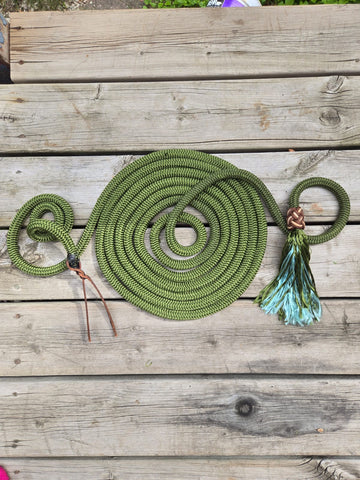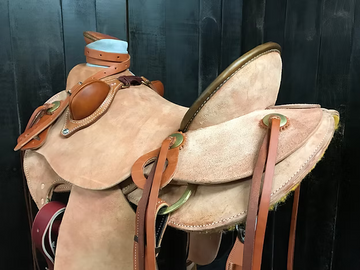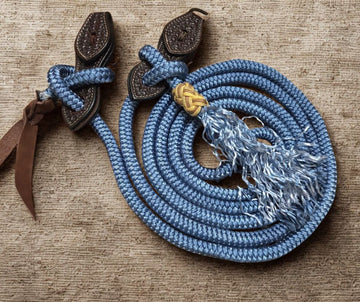Originating from the vaquero culture of the American West and the skilled horsemen of Mexico, the mecate (pronounced MeCAWtee) embodies centuries of horsemanship wisdom passed down through generations. Its name, derived from the Spanish word "mechate,"--meaning "fuse"-- speaks to its fundamental purpose: to serve as a versatile tool for connection and guidance between horse and rider.
The evolution of mecate making
In the early days of vaquero culture, mecates were crafted by hand using techniques passed down through generations. Skilled artisans would painstakingly create these intricate reins, incorporating intricate braiding and weaving patterns to ensure both beauty and functionality. Today, mecates are still crafted with care and attention to detail, preserving the legacy of craftsmanship that defines the vaquero tradition.
What materials are used to make a mecate?
Traditionally made from the mane hair of the vaquero’s horses, many other materials can be used including mohair, alpaca, wool, cotton, and double braid yacht rope.
Natural materials
Using natural materials like horsehair, alpaca wool, and mohair for mecates offers numerous benefits that enhance both functionality and aesthetics.
Horsehair mecates, known for their texture and grip, are especially useful in teaching a horse to neck rein, as the slight prickliness of the horsehair provides clearer signals to the horse, encouraging responsiveness. Alpaca wool adds softness while maintaining strength, offering comfort for both horse and rider. Mohair, with its elasticity and moisture-wicking properties, ensures durability and helps mecates maintain their shape over time. In addition to these, those seeking a budget friendly option may opt for plain cotton ropes.
These natural fibers not only uphold the traditional craftsmanship of tack but also promote sustainability, as they are renewable and eco-friendly materials.
Paracord
Paracord 550 is an excellent material for making mecates due to its strength, flexibility, and durability. As a lightweight yet incredibly strong nylon cord, paracord 550 can withstand high tension without stretching or breaking, making it reliable for everyday riding or training. Its smooth texture provides a comfortable grip, while the wide range of available colors allows for fully customizable designs. Additionally, paracord is weather-resistant, quick-drying, and easy to clean, ensuring your mecate remains functional and looking great in all conditions. Paracord mecates offer a perfect blend of performance, versatility, and style.
Double braided yacht rope
Double braided yacht rope has a few advantages: it is abrasion resistant, stays soft for years, and has a great feel favored by many natural horsemanship trainers and clinicians. The main advantage of yacht rope is that it is very budget-friendly compared to mecates made from natural animal fibers.
Design choices to be made
There are several design choices to consider when making a mecate.
Snaffle or Hackamore?:
The first design choice is whether you plan on using it with a snaffle, a hackamore (jaquima) bosal setup, or just attaching it to a rope halter. If you are using the mecate with a snaffle, you’re likely going to want a set of slobber straps, which acts as a pre-signaling tool and connects your mecate to the bit. If you are attaching it to a halter or bosal, you needn’t bother.
Mecate Ends:
The second thing to consider is what kind of ends you want. Usually, people will attach leather poppers on both sides, or one side will have a leather popper and the other a tassel made from the rope itself.
A note on leather poppers: these are very easy to make, but if you specifically buy “leather poppers” rather than just the raw materials, it will be more pricy for you. If you don’t mind this, carry on! However, if you want to make your mecate more budget friendly, you can cut out the leather poppers from an old belt or other scrap leather item with a utility knife or scissors.
Rope Diameter:
The third thing to consider is rope diameter. If you are using it with a bosal, you traditionally will use the same diameter of mecate as your bosal. For example, if you are starting a horse in a bosal for the first time, you will typically use a 5/8” bosal and mecate. As you progress with your training, the bosal and mecate rein will get gradually smaller but almost always the same diameter as each other.
As a general rule: a 5/8” diameter is the most commonly used on a snaffle bit or horse just starting in the bosal.
½” is more suitable for kids or adults with small hands, or for people who do a lot of roping. It can be difficult to hold a 5/8” mecate and a lariat rope all in one hand, especially if you're riding a green horse or are a newer rider.
Rope Length:
Finally, the last thing to consider is rope length. Most mecates are between 20’-24’ long, but you can make them longer or shorter depending on your needs. If you want a mecate for your pony, you can (and should!) make it shorter than the one for your 17hh draft cross or you’ll be drowning in excess rope.
The traditional mecate length for most horses is 22’ long on a hackamore setup or 20’ if used with a snaffle bit. A 22’ mecate allows for a 9’ or 10’ loop rein with a 12’ lead off from the left side, but this is fully adjustable to your preferences. Over the years, people started using slightly longer ropes as many people prefer to ride with a “draping” rein.
The standard length many riders prefer nowadays is a 24’ mecate used on a bosal or a 22’ mecate used for a snaffle bit. The 24’ length allows for plenty of wraps around the bosal, but still leaves enough rope in the reins to ride with a draping rein. The excess rope is then wrapped around the saddle horn or tucked into the rider’s belt, so when the rider needs to get off, they can easily use the mecate to lead or tie the horse, open a gate, or walk them through a challenging obstacle.
Conclusion
Whether you prefer the classic elegance of a horsehair mecate or the modern convenience of a braided paracord option, the mecate remains a timeless symbol of the vaquero way of life. By understanding the history and benefits of these essential tools, riders can deepen their connection with their horses and honor the rich heritage of the American West.




